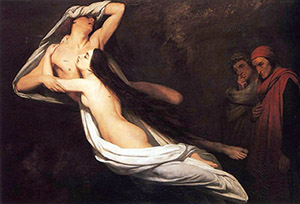Canto (1973)
Cantata for Soprano, Tenor and Chamber Orchestra or Chamber Ensemble
Texts from Dante’s Inferno and Le Livre de Lancelot del Lac (Anonymous)
Duration: 10 minutes
Orchestra: Soprano, Tenor; 2222/2000/timp/pf/str
Chamber: Flute/clarinet/ violin/ cello/piano/percussion
Review: The complex literary layout of Canto – the soprano singing a passage in Italian from Dante’s Inferno against a French Arthurian lyric sung by the tenor – compels the listener to enter into a special world…the vocal parts came together in a chillingly erotic climax… |
 Ary Scheffer, Paolo and Francesca (1858) |
An uncommonly expressive short piece…one not unfavorably suggestive of a compounding of the luminous elements of Debussy’s Pelléas et Mélisande with the darker expressionism of Berg’s Wozzeck.”
Robert Riley, Los Angeles Times
Program Note:
Canto (1973/82) is a short narrative cantata for soprano and tenor with prominent solo parts for cello and piano. Modeled on 13th-Century secular motets, in which two contrasting texts are set simultaneously, Canto is the first of the composer’s long series of works inspired by medieval subjects. The soprano solo (sung in Italian) is taken from Dante’s Inferno, Canto V, in which Francesca da Rimini tells Dante and Virgil, his guide, how she came to be in Hell’s circle for carnal sinners: One day she was reading the story of Lancelot and Guinevere with Paolo, her husband’s youngand handsome brother, when they were carried away by the beauty of the narrative into a passionate kiss and were subsequently murdered by her enraged husband. The tenor solo, from Le Livre de Lancelot del Lac (sung in French), is the anonymous 13th-century passage which inspired Paolo and Francesca. The two texts are set in alternating lines, in the manner of a series of cinematic flash-backs, as Francesca recalls the incident.
The music throughout is generated by the rhythm of the two languages, the result being two alternating tempos and two distinct types of melodic contour. A row is thus used only in the soprano and piano solos to suggest the present. The more severe tenor and cello solos remain closer to tonality to suggest the past, as the voice makes extensive use of repeated notes in the declamation of the simple French narrative. The two styles become one as the singers finally sing together at the climax of the work:
…kissed my mouth |
Great was the joy
|
Text (translation): |
|
Soprano: From Commedia, Dante Alighieri The second circle of Hell, that of There is no greater sorrow than to
One day, for delight, we read of
was our defeat.
When we read of the smile so long kissed my mouth
|
Tenor: from Le Livre de Lancelot del Lac, A narrative of Lancelot and Guenevere
“Lady,” said Lancelot, “if I could “Lady,” said he, “if you so wish, “Then, in God’s name,” says he, “let it be so…” And he drew away
Great was the joy for long had each suffered for the other. they parted. |